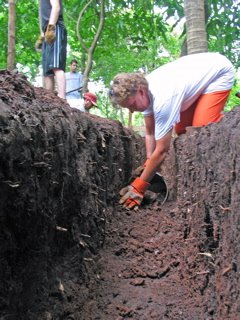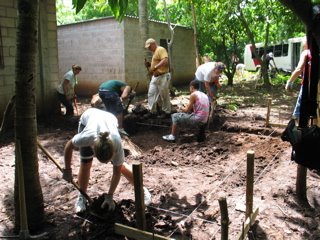Reflections on the Church in El Salvador by Chris Hedge
How would you react? How would it feel to have one of our kids rounded up and arrested in a church and accused of being a gang member just because of where he was or who she was sitting with?
This is what happened the week before we left for El Salvador. The news we got in the states was that dangerous street kids were rounded up and now were off the streets of San Salvador. But when we worshipped and studied with the members of the Resurrection Lutheran Church in San Salvador we heard the rest of the story. That gang members and good kids alike were rounded up in a church during a funeral. The sermon that was delivered by Bishop Gomez when we visited his congregation openly chastised the government for entering a church and arresting people. HIS SERMON called the governement to task for recent price hikes in bus fares and electric bills that unduly burdened the poor. He spoke for the people of his community and seemed to be reminding the government that they too should be advocates for the poor. We learned that Bishop Gomez has weekly press conferences and makes radio addresses. He reminded me of Jiminy Cricket in the old Disney version of Pinocchio. He speaks as the conscience of his country. The voice for the voiceless. This is the role of the church in El Salvador today. To speak for social justice, to point out the sins of the political elite and government, and to help alleviate poverty and hunger.
Bishop Gomez who we had the honor to meet is a current day prophet. He is continuing the work of the church in El Salvador that began in the 1970s with the Catholic Archbishop Oscar Romero. Both of these men see the mission of the church as being the voice, the hands and the feet of Christ in today's world.
Here is what Archbishop Romero said about what it means to be church in 1978:
This is the mission entrusted to the church, a hard mission: to uproot sins from history, to uproot sins from the political order, to uproot sins from the economy, to uproot sins wherever they are...If you were alive during the 1970s and 80s you might remember the civil war in El Salvador and the brutal assassinations of Jesuit priests, nuns and 10s of thousands of citizens. The church under the leadership of Oscar Romero spoke out against the repression of the people, against the kidnappings and human rights abuses of the government. Our trip to El Salvador included visits to the places where these murders occurred and to the church where Oscar Romero was assassinated while celebrating mass. It was a sobering day for all of us to see where people lost their lives trying to live out the gospels.
The church's place is by the side of the poor, of the outraged, of the rejected.Today as in the 1970s the church is the conscience of El Salvador. The night we had dinner at the home of Bishop Gomez he told us the story of his kidnapping by death squads, in the 1980s, and how he avoided assassination numerous times. In 1989, his Lutheran congregation wrote the sins of the government on a cross. This cross was kidnapped along with 15 brothers and sisters in Christ and labeled "a subversive cross" by the government. Today that subversive cross stands at the front of the sanctuary as a reminder for the church to continue to be the conscience of the nation.




